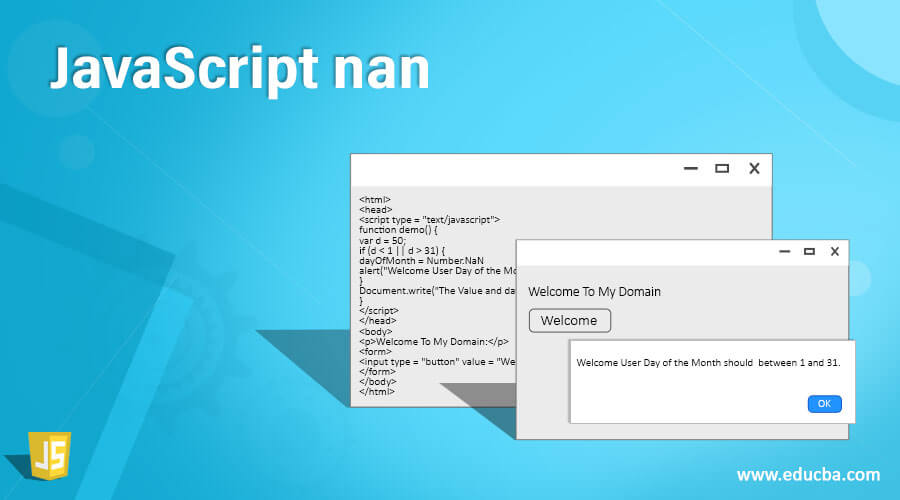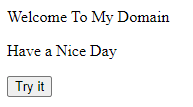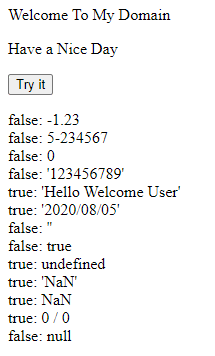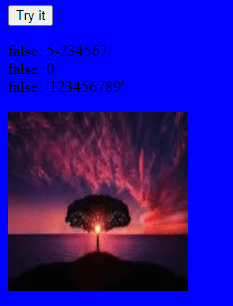Updated April 3, 2023

Introduction to JavaScript nan
The JavaScript isNaN() is one of the default methods for to determines whether the user-specified values are NaN or not, or else it will be coercion of inside the isNaN method it shows and specified for calculating the rules it may be alternatively that want to be used with the numbers, strings, etc. but all these set to be declared using “var” keyword in script any way some times numbers are called as Integers, etc. these should be used as the methods like Number.isNaN() it’s already specified in the ECMA script is also accepted in JavaScript technology.
Syntax and Parameters
In javascript, each built-in method has its own syntax, and properties of its attributes will be used as the functionality of the web applications.
<html>
<body>
<script>
function name()
{
if(isNaN(variable name)
{
--some javascript logics----
}
}
</script>
</body>
</html>The above codes are the basic syntax of the isNaN() method in the JavaScript function that can be used in the web pages with different scenarios. Based on the user requirements, these methods and nan values are validated in the client browser itself. Mainly it should be validated in the number format datatype values; it should calculate the date, time will calculate using milli also nanoseconds.
How does nan work in Javascript?
Generally, NaN means Not a Number; it’s most probably used to indicate whether the method contains either error or any exceptions that occurred in the condition loop for the functions. It should be returned with the any type of number; it should be a valid one because if suppose we are using invalid numbers, it automatically converted into 0 with the help of javascript. Using the isNaN() function is used to check whether the given number is NaN or not; if the number should be isNaN(), it returns the true condition and then assigns 0 as the value for automatically.NaN is also one of the property for the Not-a-Number values the same type as previous the value is not legitimate that is not a legal one the number is the same as in the NaN property. Using the isNaN() method, it takes as the global function to check if the value is a NaN value. Sometimes it still shows and returns as the numerical values as the data types, but it always as the undefined real numbers.NaN is also a special kind of function that it does not have real values so that it can be compared to itself; it does not return the true condition.
Moreover, it is not essential for equals to nothing values; it does not have the even NaN values. Some of the ways that have to be followed for NaN values can be happened like division of zero by zero, dividing an infinity number with by an infinity value, Multiplication of the infinity values by a zero, Any number of node operations in which NaN should be an operand and finally it converts the non-numeric digits like string, characters that are undefined into the numbers. Generally, ECMA scripts that should be standard with the numbers has IEEE formats if suppose we have used ECMA in floating-point of values; then the format is IEEE-754; it includes infinity values, -infinity (negative) values and also finally it can be used in the NaN type of values. So based on the NaN format, the object is to be a global one and is also a part of the Number type of objects. The NaN is an unordered collection, so the floating-point standard values when is to be compared with the NaN type of values that are always returned with an unordered set of results. NaN value is not equal to, greater than or less than anything, including themself values like comparison NaN <1 or NaN>1 or NaN == NaN or isNaN(NaN); these are some basic conditions which has to be used in the script logic.
Examples of JavaScript nan
Given below are the examples of JavaScript nan:
Example #1
Code:
<!DOCTYPE html>
<html>
<body>
<p>Welcome To My Domain</p>
<p>Have a Nice Day</p>
<button onclick="demo()">Try it</button>
<p id="first"></p>
<script>
function demo() {
var result = "";
resultult = result + isNaN(123456) + ": 123456<br>";
result = result + isNaN(-1.23456) + ": -1.23<br>";
result = result + isNaN(5-234567) + ": 5-234567<br>";
result = result + isNaN(0) + ": 0<br>";
result = result + isNaN('123456789') + ": '123456789'<br>";
result = result + isNaN('Hello Welcome User') + ": 'Hello Welcome User'<br>";
result = result + isNaN('2020/08/05') + ": '2020/08/05'<br>";
result = result + isNaN('') + ": ''<br>";
result = result + isNaN(true) + ": true<br>";
result = result + isNaN(undefined) + ": undefined<br>";
result = result + isNaN('NaN') + ": 'NaN'<br>";
result = result + isNaN(NaN) + ": NaN<br>";
result = result + isNaN(0 / 0) + ": 0 / 0<br>";
result = result + isNaN(null) + ": null<br>";
document.getElementById("first").innerHTML = result;
}
</script>
</body>
</html>Output:
Example #2
Code:
<html>
<head>
<script type = "text/javascript">
function demo() {
var d = 50;
if (d < 1 || d > 31) {
dayOfMonth = Number.NaN
alert("Welcome User Day of the Month should between 1 and 31.")
}
Document.write("The Value and dayOfMonth is: " + d );
}
</script>
</head>
<body>
<p>Welcome To My Domain:</p>
<form>
<input type = "button" value = "Welcome" onclick = "demo();" />
</form>
</body>
</html>Output:
Example #3
Code:
<!DOCTYPE html>
<html>
<head>
<style>
.img
{
opacity:0.8;
filter: alpha(opacity=1);
background-color: red;
padding: 11px;
font-smooth: 5em;
}
</style>
</head>
<body bgcolor="blue">
<button onclick="demo()">Try it</button>
<p id="first"></p>
<img src="first.jpg" alt="transparent images " width="180" height="179">
<script>
function demo() {
var result = "";
result = result + isNaN(5-234567) + ": 5-234567<br>";
result = result + isNaN(0) + ": 0<br>";
result = result + isNaN('123456789') + ": '123456789'<br>";
document.getElementById("first").innerHTML = result;
}
</script>
</body>
</html>Output:
Conclusion
JavaScript uses a different set of built-in methods; among that isNaN () is one of the frequent methods and values for comparing the numeric and non-numeric values in the applications. If the requirement happens, it should be validated in the client browser with the help of predefined conditions.
Recommended Articles
We hope that this EDUCBA information on “JavaScript nan” was beneficial to you. You can view EDUCBA’s recommended articles for more information.







